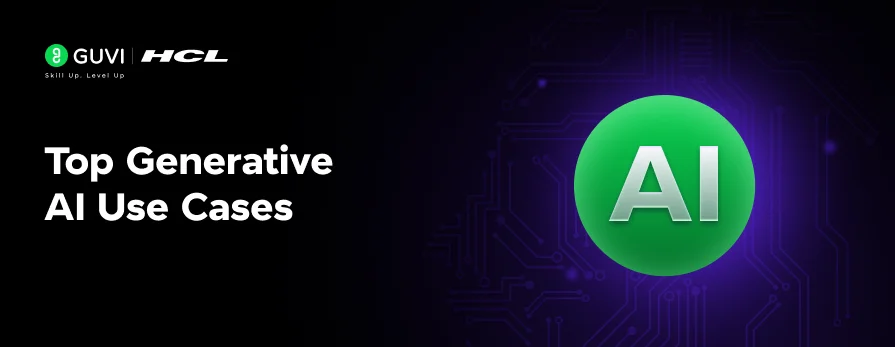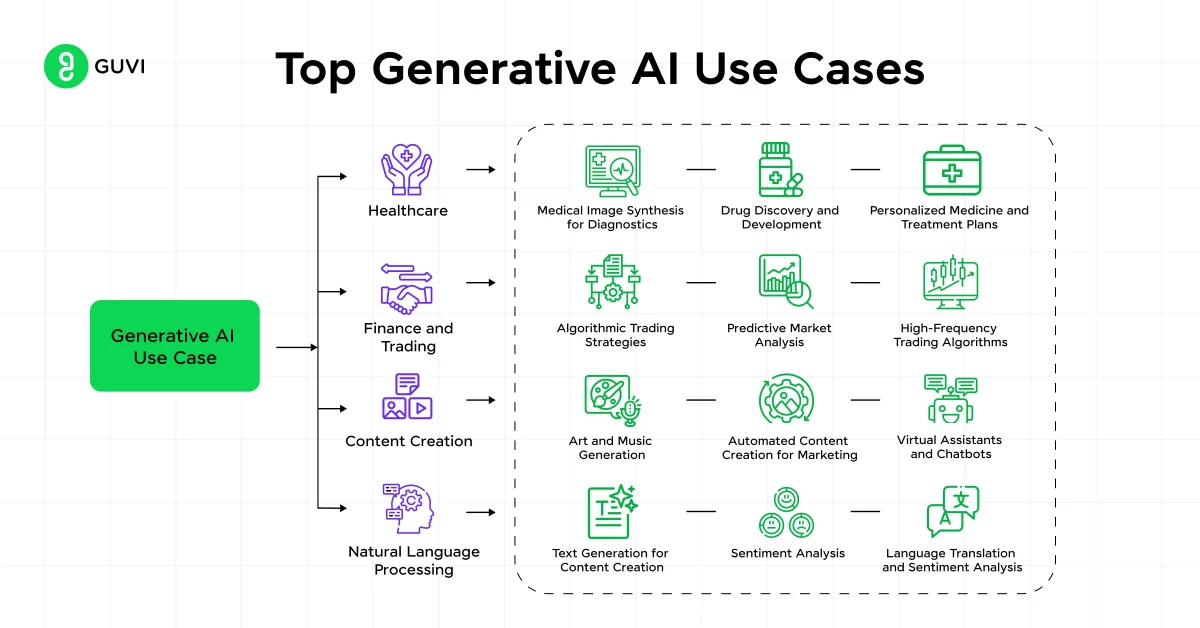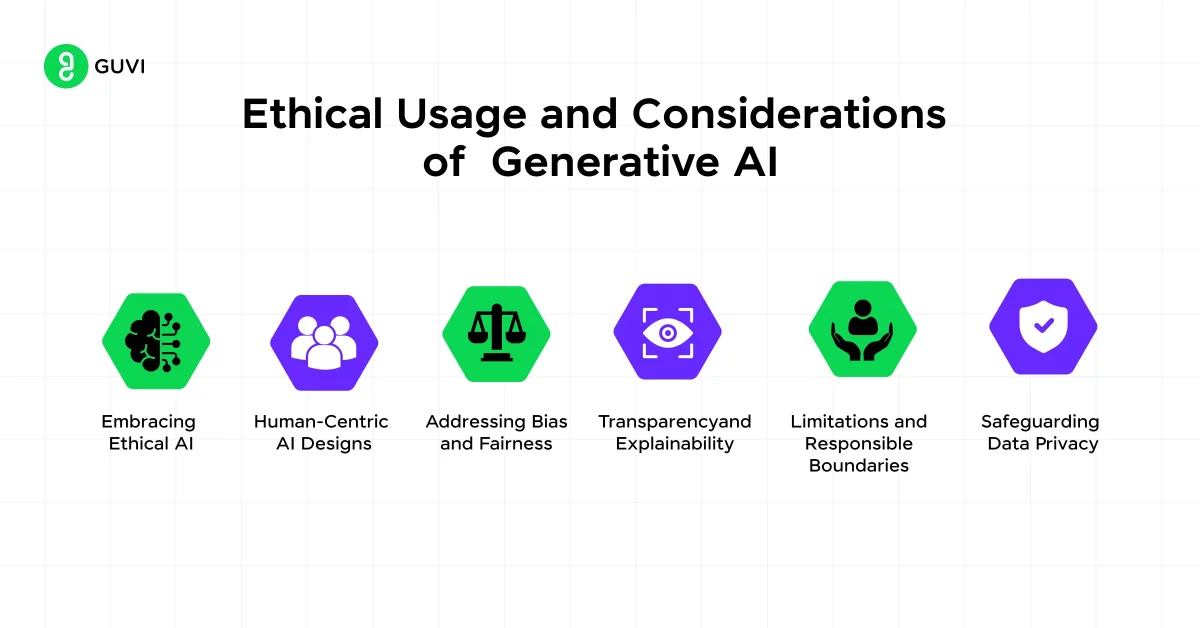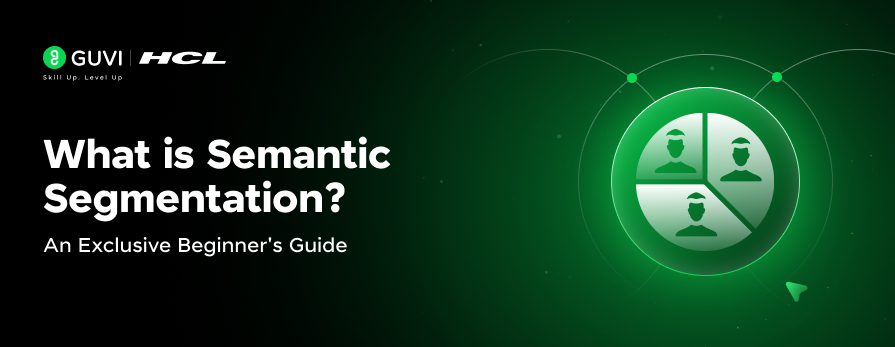
Top Generative AI Use Cases
Jun 09, 2025 5 Min Read 2927 Views
(Last Updated)
The world is now filled with technology all around us and one prominent tech out of all is Artificial Intelligence. We use them on a daily basis without even knowing it consciously.
Generative AI, a subset of artificial intelligence that creates content like texts, videos, music, and whatnot on its own without relying on a reference is gaining popularity among the general public.
Where and all we are using this generative AI? That’s what this article is going to be about, understanding the Generative AI use cases and its functionalities. So, let us get started!
Table of contents
- Top Generative AI Use Cases
- Content Creation
- Design and Art
- Music Composition
- Coding Assistance
- Customer Support and Chatbots
- Healthcare and Medical Research
- Gaming and Entertainment
- Personalized Marketing
- Finance and Risk Management
- Education and E-Learning
- Ethical Usage and Considerations of Generative AI
- Bias and Fairness
- Privacy
- Misinformation
- Intellectual Property
- Transparency
- Job Displacement
- Conclusion
- FAQs
- How does generative AI differ from traditional AI?
- Can generative AI replace human creativity?
- Is generative AI expensive to implement?
- What are some popular tools for generative AI in content creation?
- Can generative AI help in coding?
- How can generative AI be used responsibly?
Top Generative AI Use Cases

Generative AI is transforming industries in ways that were hard to imagine just a few years ago. Whether you’re a tech enthusiast or someone with a foundational understanding of AI, understanding where and how generative AI is being used can open up new possibilities for you.
Let’s understand some of the top generative AI use cases:
1. Content Creation
Generative AI is a game-changer for content creators. From writing blog posts and articles to generating social media content, AI tools like GPT-4 are enabling creators to draft content quickly.
You can provide a brief input, and the AI generates text that’s coherent and engaging. This doesn’t mean AI is replacing writers, rather, it’s acting as an assistant, helping you brainstorm ideas, generate drafts, and even refine your writing.
- Example: Tools like Jasper AI and Copy.ai can generate marketing copy, social media posts, or even entire blog articles based on a few keywords or phrases you provide. You can think of it as a digital writing assistant that helps get your ideas down on paper faster.
2. Design and Art
If you’re into graphic design or digital art, generative AI tools are powerful and resourceful. Tools like DALL-E allow you to create unique images based on textual descriptions.
Whether you’re working on logo design, digital illustrations, or even animations, AI can generate visuals that match your specifications. It’s like having an endless creative assistant that can bring your ideas to life in seconds.
- Example: DALL-E 2 and Midjourney are AI tools that can generate images based on textual descriptions. For example, if you describe “a futuristic city at sunset,” these tools can create a stunning image that matches your description. This saves you time and effort in creating visuals from scratch.
3. Music Composition
Generative AI is also making waves in the music industry. If you’re a musician or composer, AI can help generate melodies, harmonies, and even full compositions.
If you want to learn more about Gen AI through a self-paced course that includes industry-grade certification, consider enrolling in GUVI’s Generative AI Course which teaches you everything related to it!
Tools like OpenAI’s MuseNet or AIVA can create music in various styles, giving you a fresh source of inspiration. This is especially useful when you’re stuck in a creative rut or looking for new musical ideas.
- Example: AIVA (Artificial Intelligence Virtual Artist) and Amper Music are AI tools that can generate music in various styles, from classical to electronic. You simply choose the style, tempo, and mood, and the AI generates a piece of music. It’s like having a collaborator who never runs out of ideas.
4. Coding Assistance
For those of you in software development, generative AI can assist in writing code as well. Certain tools can generate code snippets based on your input, speeding up the development process.
Whether you’re debugging, writing documentation, or even creating entire functions, AI can act as a helpful coding partner, allowing you to focus on more complex tasks.
- Example: GitHub Copilot is an AI-powered tool that helps you write code faster. If you’re stuck on a particular function or need to automate repetitive tasks, Copilot can suggest code snippets or even complete entire lines of code for you. It’s like having a coding buddy who’s always available.
5. Customer Support and Chatbots
Generative AI is revolutionizing customer support by powering intelligent chatbots. These AI-driven bots can handle customer queries, troubleshoot problems, and even make product recommendations.
If you’re in a customer-facing role, AI chatbots can take care of routine inquiries, allowing you to focus on more critical customer interactions. Companies like Zendesk and Intercom are already using AI to improve customer service efficiency.
- Example: ChatGPT and Zendesk AI are examples of AI-powered customer support tools. These chatbots can answer frequently asked questions, troubleshoot basic problems, and even guide customers through product features. This makes customer service more efficient and accessible.
If you are intrigued by the working nature of ChatGPT and want to learn more about it, consider enrolling for GUVI’s ChatGPT Course that covers every aspect related to it!
6. Healthcare and Medical Research
In healthcare, generative AI is being used to analyze medical images, predict patient outcomes, and even assist in drug discovery.
If you’re in the medical field, generative AI can help you process large datasets, identify patterns, and provide insights that might be difficult to uncover manually. This is particularly useful in areas like radiology, where AI can assist in diagnosing diseases from X-rays or MRIs.
- Example: IBM Watson Health uses AI to analyze medical data, helping doctors diagnose diseases and recommend treatments. For example, AI can examine thousands of patient records to identify patterns that may indicate a certain condition. This helps doctors make more informed decisions.
7. Gaming and Entertainment
Generative AI is also reshaping the gaming industry. If you’re a game developer or a player, you’ve probably noticed the increasing use of AI in creating game environments, characters, and narratives.
Gen AI can generate realistic scenarios, dialogues, and even entire game worlds, making the gaming experience more immersive and personalized.
- Example: AI Dungeon is a game that uses AI to generate interactive stories where you control the narrative. You can type in any action or dialogue, and the AI will respond with new scenarios, making the game feel limitless in possibilities.
8. Personalized Marketing
For those of you in marketing, generative AI can help create personalized marketing campaigns. AI can analyze customer data to generate tailored content, advertisements, and product recommendations.
Whether you’re working on email campaigns, social media ads, or content marketing, AI can help you reach the right audience with the right message.
- Example: Persado is an AI-powered marketing platform that creates personalized messaging for emails, social media, and ads. By analyzing customer data, it generates content that resonates with the target audience, increasing engagement and conversion rates.
9. Finance and Risk Management
In finance, generative AI is being used for tasks like fraud detection, risk management, and financial forecasting.
If you’re in the financial sector, AI can help you analyze market trends, predict financial risks, and even automate trading. This not only improves efficiency but also reduces the likelihood of human error.
- Example: Kensho is a financial AI tool used by companies like S&P Global to analyze financial data and predict market movements. For example, it can analyze past trends to forecast stock prices or identify potential risks in an investment portfolio.
10. Education and E-Learning
Generative AI is making education more accessible and personalized. If you’re an educator or a learner, AI can create customized learning paths, generate educational content, and even provide real-time feedback.
- Example: Khan Academy uses AI to provide personalized learning experiences. Based on your progress, the AI can suggest new topics, generate practice questions, and offer feedback on your performance. This helps you learn at your own pace.
Generative AI use cases are more than just a futuristic concept; it’s already making a significant impact across various fields. By understanding these generative AI use cases, you can better see how AI might fit into your own work or life.
Ethical Usage and Considerations of Generative AI

Generative AI is a powerful tool, but with great power comes great responsibility. When using Gen AI, it’s important to consider the ethical implications to ensure that its usage is fair, transparent, and respectful of others.
1. Bias and Fairness
AI models are trained on vast amounts of data, and sometimes this data can include biases whether intentional or not. This means AI might produce outputs that are unfair or discriminatory.
For example, an AI tool generating job descriptions might unintentionally favor certain genders or races based on the data it was trained on. To avoid this, it’s crucial to use diverse datasets and regularly check AI outputs for any signs of bias.
2. Privacy
Generative AI often relies on personal data to function, especially in areas like customer service or personalized marketing. It’s essential to respect users’ privacy and only use data that people have willingly shared.
Always ensure that personal data is anonymized when possible, and follow regulations like GDPR that protect users’ privacy.
3. Misinformation
AI can generate content that looks real, even if it’s not based on facts. This can lead to the spread of misinformation, especially if AI-generated content is used in news, blogs, or social media.
To combat this, always fact-check AI-generated content before sharing it and make it clear that the content was generated by AI.
4. Intellectual Property
When AI generates creative content like art or music, it’s important to consider who owns the rights to that content. Is it the person who used the AI tool, the developers of the AI, or someone else?
Currently, laws around AI-generated content are still evolving, so it’s wise to understand the terms of use for any AI tool and respect the rights of original creators.
5. Transparency
People should know when they’re interacting with AI. If you’re using an AI chatbot on your website or AI-generated content in your work, be transparent about it. This helps build trust with your audience and allows them to understand the role AI is playing in their experience.
6. Job Displacement
AI can automate tasks that people currently do, which raises concerns about job displacement. While AI can enhance productivity, it’s important to use it in a way that complements human work rather than replacing it.
This can involve upskilling employees to work alongside AI or finding new roles that AI can’t perform.
Generative AI has incredible potential, but ethical considerations are key to using it responsibly. By being mindful of bias, privacy, misinformation, intellectual property, transparency, and job displacement, you can ensure that your use of AI benefits everyone and avoids unintended harm.
In case you want to explore more about Artificial Intelligence and Machine Learning, consider enrolling for GUVI’s Artificial Intelligence and Machine Learning courses that teaches you everything related to it with an industry-grade certificate.
Conclusion
In conclusion, the generative AI use cases are immense and important in our day-to-day lives. Starting from basic content creation to game development, generative AI plays a crucial role in every domain.
Still, ensuring fairness, protecting privacy, preventing misinformation, respecting intellectual property, being transparent, and addressing job displacement are key considerations to look out for. Using generative AI ethically is the right thing to do and it is important to keep that in mind whenever you start working with it.
FAQs
Traditional AI typically analyzes data and makes decisions based on it, while generative AI goes a step further by creating new data or content, such as writing articles or generating images.
Generative AI can assist with creative tasks by generating ideas or content, but it’s generally seen as a tool to complement human creativity rather than replace it.
The cost of implementing generative AI can vary depending on the complexity of the task and the tools being used. Some platforms offer affordable options, while advanced implementations may require significant investment.
Popular tools include Jasper AI, Copy.ai, and OpenAI’s GPT-4, which can assist with writing articles, blogs, and marketing copy.
Yes, tools like GitHub Copilot assist developers by generating code snippets, automating repetitive tasks, and even helping debug issues.
Responsible use of generative AI involves addressing biases, ensuring transparency, respecting privacy, and considering the ethical implications of AI-generated content.


















![How to Restore Old Photos with Deep Latent Space Translation: A Beginner’s Guide [2025] 7 deep latent space translation](https://www.guvi.in/blog/wp-content/uploads/2025/07/How-to-Restore-Old-Photos-with-Deep-Latent-Space-Translation.png)
![What is the Minerva Deep Learning Model? An Exclusive Beginner’s Guide [2025] 8 minerva](https://www.guvi.in/blog/wp-content/uploads/2025/07/A-Beginners-Guide-to-Data-Visualization-with-Matplotlib.png)



![What is Object Detection? A Beginner’s Guide [2025] 12 object detection](https://www.guvi.in/blog/wp-content/uploads/2025/07/What-is-Object-Detection_-A-Beginners-Guide.png)

Did you enjoy this article?